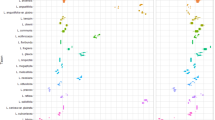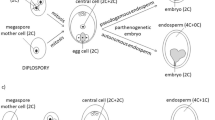Abstract
Feulgen/DNA cytophotometric determinations carried out in the root meristem of seedlings showed that substantial quantitative alterations in the nuclear genome are present between and within 15 natural populations of Dasypyrum villosum in Italy. When the most variant values are considered, there is a 17.6% difference between the mean genome size of the populations, and a 66.2% difference between the genome size of individual plants within a population. A highly significant, positive correlation was found to exist between the genome size of D. villosum plants and the altitude of their stations, and differences in DNA contents between individual plants were greater in populations from mountain sites. Karyological analyses showed all chromosome pairs to differ largely in size between plants with differing DNA contents. A highly significant, positive correlation was found to exist between genome size and both the length of the chromosome complement at metaphase and the length and arm ratio of pair VII. Significant correlations were also found between DNA content and certain phenotypic characteristics of the plants. The mean genome size of the populations was negatively correlated with the mean leaf length and width. In contrast, the genome size of individual plants was positively correlated with the weight of the seed from which they originated and their flowering interval. A large range of genome sizes was found in the half-sib progeny of a plant having a relatively large genome. In contrast, in the half-sib progeny of a plant having a small genome, the genome sizes of the individual plants were less divergent and similar to that of the mother plant. All siblings from crosses between plants with differing genome sizes had similar DNA contents, which were intermediate between those of the parental plants, even if closer to the DNA content of the parent plant having the smaller genome size. Size polymorphism within pairs was never observed in plants obtained from these crosses or in half-sibs whose genome size differed from that of the mother plant. The intraspecific alterations observed in the nuclear genome and their effects on plant development and phenotype are briefly discussed as evolutionary factors which allow D. villosum populations to withstand different environmental conditions as well as the variability of conditions in a given environment.
Similar content being viewed by others
Author information
Authors and Affiliations
Additional information
Received: 6 October 1997 / Accepted: 28 October 1997
Rights and permissions
About this article
Cite this article
Caceres, M., De Pace, C., Mugnozza, G. et al. Genome size variations within Dasypyrum villosum: correlations with chromosomal traits, environmental factors and plant phenotypic characteristics and behaviour in reproduction. Theor Appl Genet 96, 559–567 (1998). https://doi.org/10.1007/s001220050774
Issue Date:
DOI: https://doi.org/10.1007/s001220050774




